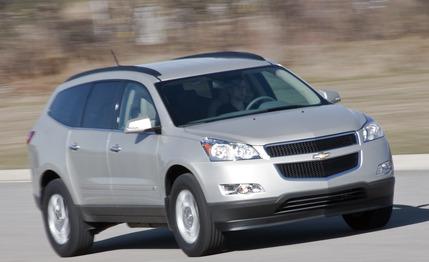 Short Take Road Test
Short Take Road Test
Here we are, testing yet another of GM’s Lambda-platform crossovers, which include the Buick Enclave, the GMC Acadia, and the Chevrolet Traverse. But this time we’re looking at a front-wheel-drive variant powered by the direct-injected 3.6-liter V-6; it’s our first deep dive into the combo since the trio received the engine way back for the 2009 model year.
In planning our test, we theorized that such a Lambda—in this case a 2010 Chevrolet Traverse LT—would get better gas mileage, which, combined with a lower entry price, would make it a more affordable and more attractive alternative to the all-wheel-drive model. We based our theory on the fact that the front-driver is lighter by 213 pounds and has a lower amount of efficiency-sapping drivetrain friction than the all-wheel-drive model. Then we tested the thing and found out our theory was wrong: This Traverse got 17 miles per gallon, 1 mpg fewer than the all-wheel-driver we evaluated last year.
We’re Smoking . . . Tires
So what gives? Why did the front-wheel-drive Traverse use more dino-juice per fathom? Well, the EPA numbers differ by only 1 mpg in both city and highway tests (17/24 for the FWD model versus 16/23 for AWD), so any real-world fuel-economy advantage likely would be negligible anyway. The two weren’t driven on identical loops, which was a factor, and conditions often were wet during our test, making takeoff tricky with 281 hp and 266 lb-ft of torque coursing through just two wheels. We basically stayed in the throttle until we were moving at a satisfactory pace, so your mileage may vary—scratch that, will vary and surely improve with a more measured driving style.
During a dry day at the test track, the FWD Traverse posted a 7.3-second 0-to-60-mph time, 0.3 second quicker than the all-wheel-driver. It also won in the quarter-mile, but just barely: a 15.8-second jog at 91 mph versus 15.9 seconds at 88 mph for the all-wheel-driven crossover. Despite the weight disparity, braking performance from 70 mph was spot-on equal—which is to say dismal—at 194 feet. Skidpad grip was another repeatable experiment, measuring 0.79 g for both iterations.
As with the AWD version, the interior of the FWD Traverse is comfortable, if somewhat plasticky. (The GMC and Buick offer better cabins, but you’ll pay for it.) Like all Lambdas, the Traverse is smooth and quiet on the highway, with plenty of power to move its 4741 pounds. Our tester’s front-wheel-drive-ness was betrayed only by the aforementioned wheelspin off the line and an occasional light torque-steer tug at the wheel. Our 2LT example stickered for $39,185, with the options tally including leather seating with heated front chairs ($1775); a rear-seat DVD package ($1445); a bundle of Bluetooth, remote start, and built-in garage opener ($340); and a tow package ($525). A power liftgate, three-zone climate control, and a rearview camera were among the standard features. A similarly equipped all-wheel-drive Traverse would cost two grand more.
Minivans Make More Sense
Going back to the idea of theories, our fuel-economy one was interesting, but there’s another theory that figures prominently into placing this crossover in the automotive universe. Namely, GM’s assertion that its big crossovers make good minivan replacements—after all, the company stopped building minivans in favor of the Lambdas. We agree with GM if you need to haul seven or eight people up an Alpine slope. There’s just one minivan, the Toyota Sienna, currently available with all-wheel drive, providing good justification for AWD crossovers at large, if only for the sake of choice. But if moving people through fair weather is your main task, why bother with a heavier, more-ponderous-feeling crossover? You can’t beat a minivan’s packaging efficiency and ease of ingress and egress—sliding doors, woo!—and they even have lower base prices. If it were our money, we’d skip the front-drive crossover and buy a minivan. Well, if minivans weren’t so damn dowdy, that is.